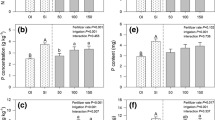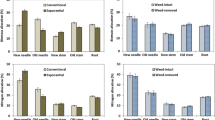Abstract
Fertilization is essential to seedling production in nursery culture, but excessive fertilization can contaminate surface and ground water around the nursery. The optimal fertilization practice is that which maximizes seedling growth and minimizes nutrient loss. We tested three fertilization strategies: (1) constant fertilization (2) a three-stage rate, and (3) exponential fertilization on Liriodendron tulipifera and Larix leptolepis containerized seedlings. Growth performance, nutrient uptake, and nutrient loss in leaching were measured. Height, root collar diameter, and dry weight of both species were not significantly different among treatments even though the nutrient supply of the exponential treatment was half that of the constant and three-stage treatments. Generally, nutrient losses in leached solutions were higher in constant and three-stage than the exponential treatment. Nutrient use efficiency was calculated as the ratio of the nutrient content of the seedlings to the amount of nutrient applied to the containers. The nitrogen use efficiency in the constant, three-stage, and exponential treatments was 63, 61, and 85% for yellow poplar, respectively, and 35, 30, and 53% for larch. Similar results were obtained for phosphorus and potassium. Thus, the exponential treatment had the highest nutrient use efficiency as well as the least nutrient loss. Adjusting fertilization rates can reduce soil and water contamination around the nursery without compromising growth performance, which reduces both producer’s investments and environmental impacts.




Similar content being viewed by others
References
Andersen L, Hansen CW (2000) Leaching of nitrogen from container plants grown under controlled fertigation regimes. J Environ Hortic 18:8–12
Auchmoody LR (1974) Nutrient composition of blades, petioles, and whole leaves from fertilized and unfertilized yellow-poplar. USDA forest service research note NE-198
Bremner JM (1965) Total nitrogen. In: Black CA (ed) Methods of soil analysis. Part 2. Agronomy 9. American Society of Agronomy, Madison, pp 1149–1178
Broschat TK (1995) Nitrate, phosphate, and potassium leaching from container-grown plants fertilized by several methods. Hort Sci 30:74–77
Bumgarner ML, Salifu KF, Jocobs DF (2008) Subirrigation of Quercus rubra seedlings: nursery stock quality, media chemistry, and early field performance. Hort Sci 43(7):2179–2185
Close DC, Bail I, Hunter S, Beadle CL (2005) Effects of exponential nutrient-loading on morphological and nitrogen characteristics and on after-planting performance of Eucalyptus globulus seedlings. For Ecol Manage 205:397–403
Cox MS (2001) The Lancaster soil test method as an alternative to the Mehlich 3 soil test method 1. Soil Sci 166(7):484–489
Dumroese RK, Page-Dumroese DS, Salifu KF, Jacobs DF (2005) Exponential fertilization of Pinus monticola seedlings: nutrient uptake efficiency, leaching fractions, and early outplanting performance. Can J For Res 35:2961–2967
Dumroese RK, Pinto JR, Jacobs DF, Davis AS, Horiuchi B (2006) Subirrigation reduces water use, nitrogen loss, and moss growth in a container nursery. Nat Plants J 7(3):253–261
Gordon WS, Jackson RB (2000) Nutrient concentrations in fine roots. Ecol 81:275–280
Heiskanen J (1995) Irrigation regime affects water and aeration conditions in peat growth medium and the growth of containerized Scots pine seedlings. New For 9:181–195
Imo M, Timmer VR (1999) Vector competition analysis of black spruce seedling responses to nutrient loading and vegetation control. Can J For Res 29(4):474–486
Ingestad T, Lund AB (1986) Theory and techniques for steady state mineral nutrition and growth of plants. Scand J For Res 1:439–453
Juntunen M-L, Hammar T, Rikala R (2002) Leaching of nitrogen and phosphorus during production of forest seedlings in containers. J Environ Qual 31:1868–1874
Korea Forest Research Institute (2009) Annual research report. Ukgo Printing Co, Seoul
Korea Forest Service (2009) National report on sustainable forest management in Korea 2009. Korea Forest Service, Taejon
Landis TD, Wilkinson K (2004) Subirrigation: a better option for broad-leaved container nursery crops? USDA forest service forest nursery notes summer. pp 14–17
Landis TD, Tinus RW, McDonald SE, Barnett JP (1989) Seedling nutrition and irrigation, of the container tree nursery manual, vol 4. USDA Forest Service, Washington
Landis TD, Tinus RW, McDonald SE, Barnett JP (1990) Containers and growing media of the container tree nursery manual, vol 2. USDA Forest Service, Washington
Qu LY, Quoreshi AM, Koike T (2003) Root growth characteristics, biomass and nutrient dynamics of seedlings of two larch species raised under different fertilization regimes. Plant Soil 255:293–302
Quoreshi AM, Timmer VR (2000) Early outplanting performance of nutrient-loaded containerized black spruce seedlings inoculated with Laccaria bicolor: a bioassay study. Can J For Res 30:744–752
Salifu KF, Timmer VR (2003) Optimizing nitrogen loading in Picea mariana seedlings during nursery culture. Can J For Res 33:1187–1294
Stowe DC, Lamhamedi MS, Carles S, Fecteau B, Margolis HA, Renaud M, Bernier PY (2010) Managing irrigation to reduce nutrient leaching in containerized white spruce seedling production. New For 40:185–204
Timmer VR (1996) Exponential nutrient loading: a new fertilization technique to improve seedling performance on competitive sites. New For 13:275–295
Timmer VR, Armstrong G (1987) Growth and nutrition of containerized Pinus resinosa at exponentially increasing nutrient additions. Can J For Res 17:644–647
Walkley A, Black IA (1934) An examination of the Degtjareff method for determining soil organic matter and a proposed determination of the chromic acid titration method. Soil Sci 37:29–38
Way D, Seegobin S, Sage R (2007) The effect of carbon and nutrient loading during nursery culture on the growth of black spruce seedlings: a six-year field study. New For 34(3):307–312
Wilde SA, Voigt GK, Lyer JC (1972) Soil and plant analysis for tree culture. Oxford and IBH Publishing Co, New Delhi
Acknowledgments
Data were collected by Eun Joo Jo at the Forest Practice Research Center of Korea Forest Research Institute and hundreds of solution samples were analyzed by Hye Lim Sung. We thank DF Jacobs, P Smethurst and an anonymous reviewer for their valuable comments. This research was supported by Research Funds of the Korea Forest Research Institute.
Author information
Authors and Affiliations
Corresponding author
Rights and permissions
About this article
Cite this article
Park, B.B., Cho, M.S., Lee, S.W. et al. Minimizing nutrient leaching and improving nutrient use efficiency of Liriodendron tulipifera and Larix leptolepis in a container nursery system. New Forests 43, 57–68 (2012). https://doi.org/10.1007/s11056-011-9266-8
Received:
Accepted:
Published:
Issue Date:
DOI: https://doi.org/10.1007/s11056-011-9266-8




